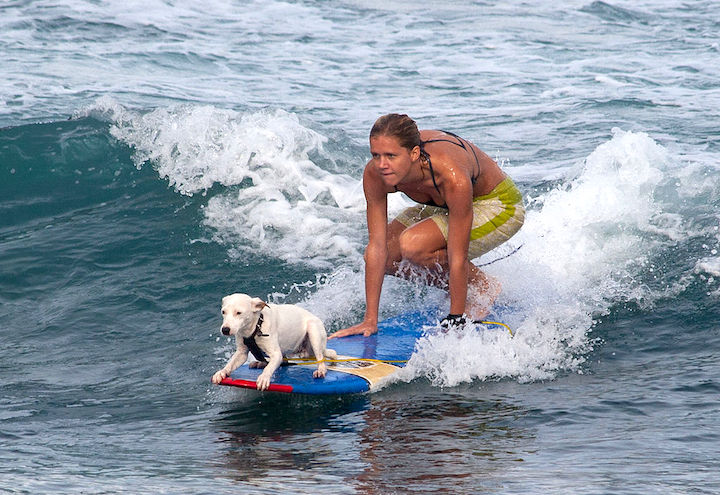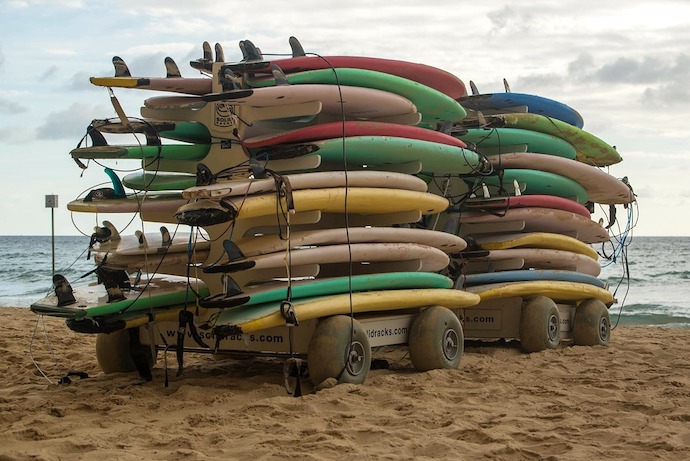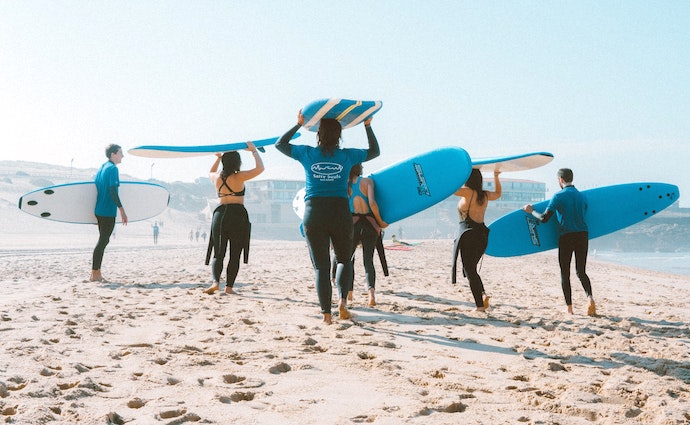
Soft top surfing is totally cool
Source: Hanging 18 – Wikimedia
Whether you’re just getting started on your surfing journey or are looking for the next board in your quiver, there’s a perfect soft top out there for you. With so many different options, it can be hard to know which board is the right one for you. So we’ll break down some of the key aspects about the soft top surfboard, so you can get an idea of the best board to fit your needs.
Why Buy a Soft Top?
The best part of a soft top surfboard is that they’re close to indestructible. The soft core and outer layer make any soft top board incredibly difficult to ding or crease. If you accidentally ran into the shore or are surfing in shallow water or just got smoked on a wave, your board will still be fine.
Soft tops are generally safer because of their soft deck and soft fins. If you crash into your own board, you come out on top against a soft top. No need to worry about taking a fin to the head and needing stitches, or wrecking your board which is probably worse.
Since soft tops are so durable, they last longer than normal boards. So if you’re on the fence about whether to buy a surfboard, soft tops will change your mind.
What Is a Soft Top?
Soft tops are boards with soft decks and usually slick, bodyboard-like bottoms. Unlike traditional boards that are usually made with polyurethane foam and then glassed with either fiberglass resin or epoxy, soft top boards are made with EPS foam, like a boogie board.
The EPS core makes soft tops very buoyant and durable. Together with the soft decks, these boards are very user friendly.
Different Types of Soft Tops

The huge choice can be daunting
Source: Patty Jansen – Needpix
Every brand has a huge range of options. Without some guidance, it can be hard to understand what board will work best for your ability and conditions. Below, we’ll look at some of the more common shapes and sizes so you know what’s best for you.
Beaters
Beaters, short for black ball beaters, are soft top surfboards that are only slightly bigger than a boogie board, usually shorter than 5 feet long. They may or may not have fins that attach to the bottom. Their primary purpose is to allow people to surf in areas that are usually designated for swimming or bodyboarding only.
Heads up, if the board has fins, you probably won’t be able to take it out in a non-surfing area.
These boards are often hard to ride if you’re a full-sized adult but are great for little groms.
Fishes
A fish board is typically in the 6 foot range but may run a little bigger or smaller. Their defining feature is their large swallow tail. The swallow tail allows for more carve on the face of the wave and increased turning capability.
These boards also have wider noses than other soft tops. Though soft tops generally have wide noses, the fish’s noses are noticeably rounder through the nose giving a little more volume in your board.
Besides having a swallow tail to help with turns, many fish soft tops have a quad fin setup. This setup helps the water channel underneath one tail point when turning and lets you surf looser. You can ride these boards as twin fins, but we found the fins sit a little too far forward to work perfectly.
Shortboard Soft Tops
Like fishes, these boards are typically in the 6 foot range, give or take 6 inches. Similar to a standard shortboard, they can turn on the face of the wave, get barrelled, and even fly if you can manage airs.
Shortboard soft tops often have a thruster fin setup with three fins, which provides a stable platform for your ride.These are easy to ride and give you a similar feeling to traditional shortboard surfing, so it’s easier to make the transition when you’re ready.
Longboard Soft Tops
Like their name suggests, longboard soft tops are much longer than the others. Usually, these are at least 8 feet long and often exceed 9’6”.
Longboard soft tops are very user friendly. They paddle easy and are incredibly stable to stand on. They make surfing on even the smallest day a blast, since you can maximize your wave count.
One thing to note about them is that the longer the board, the less maneuverable it becomes. Although you’ll be able to paddle faster and conserve energy with a longer board, turning on the wave and making critical drops can be difficult.
We’ve found 8 feet to be the sweet spot between ease of paddling and performance. At this length, the longboard soft tops are easy to paddle and catch waves but can easily turn and make steep drops to get barrelled.
Picking the Right Soft Top For Your Needs

Find the best board for your needs
Source: Elle Hughes – Pexels
Now that you have a better sense of what each type of board is used for you can find the best board for your needs.
If you’re looking for the best board for a younger kid to learn on, a beater will probably be best due to their size.
If you’re really into ripping on your soft top and just want a board that you can ride without fear of it breaking, a fish soft top is the board for you. These are maneuver-orientated and can withstand any beating. Whether you’re getting totally shacked or laying down huge carves, the fish’s size and tail will help you on the critical section of the wave.
But, if you’re like us or most other surfers, the longboard soft top is perfect. It’s a great back up board for when the waves are small or you just want to have a stress free session. They’re also great for beginners since they are the easiest to paddle and stand up on.
With their variety of different lengths, you can find a longboard soft top that works in steeper surf or on an inviting beginner wave.
Features to Look For
There are tons of different brands and options out there so it can be hard to know exactly which board is best for you. After riding a bunch of boards and looking at even more, we’ve listed some of the most important features.
Fin boxes vs bolt-thru fins
Bolt-thru fins are the easiest to install and are often much more flexible making them great for beginners. Fin boxes allow you to install a wider array of fins or put in stiffer fins of your choosing. This can make your fins more likely to fall out though.
Leash vs no leash
Some soft tops have leashes included. If you like chasing your board to the shore everytime, no leash might be for you. Need to buy a leash? Make sure you get one strong and long enough for the size of board you choose.
Stringers
Stringers are wooden rods that run the length of the board. They help keep the board stiff so it doesn’t completely fold when you put weight on it. Stringers will give the board durability and prevent major creases or folds from appearing through normal use.
We hope this guide to choosing a fun soft top board has been useful. If you have any further questions please leave a comment below and we’ll reply as soon as we can.